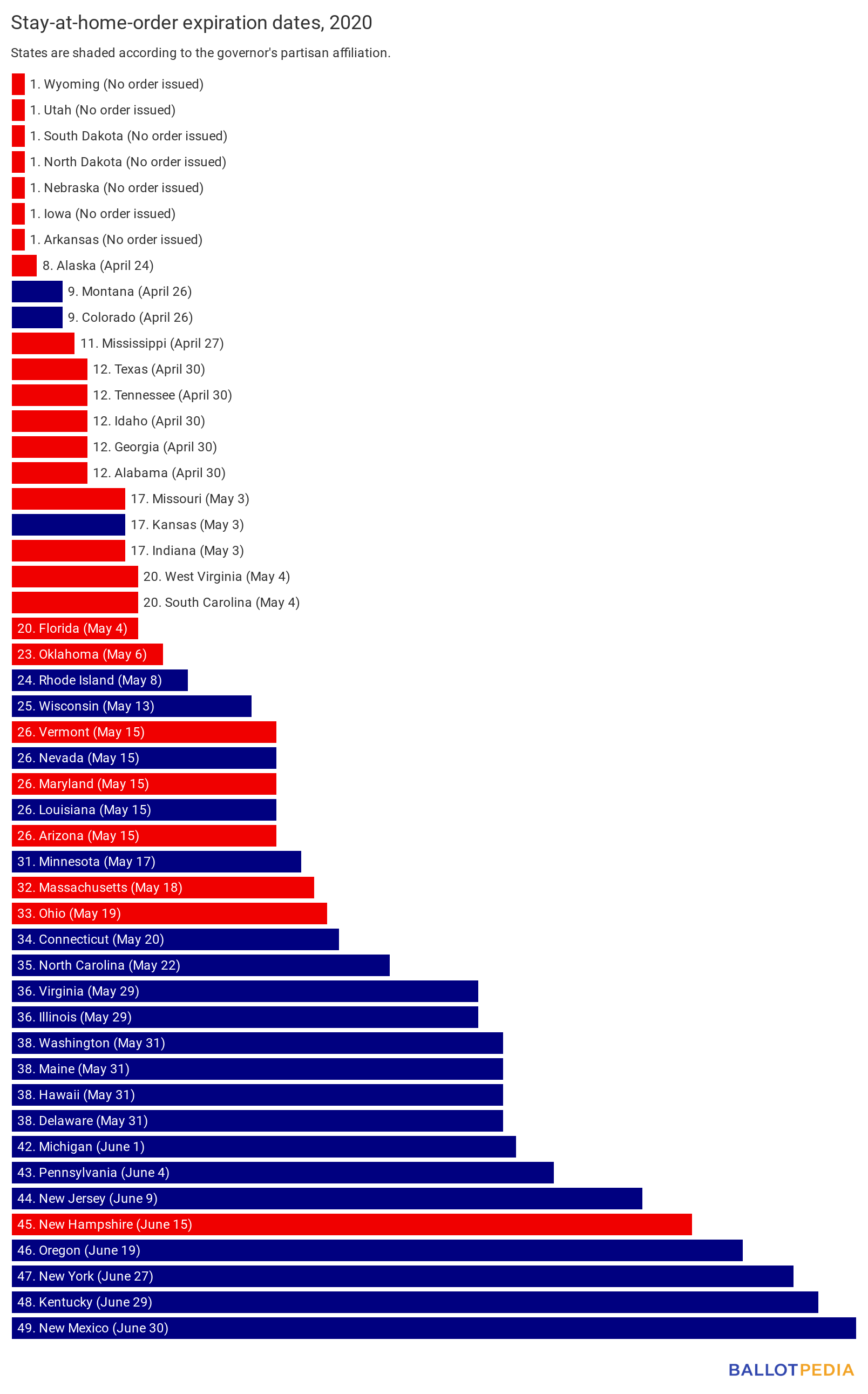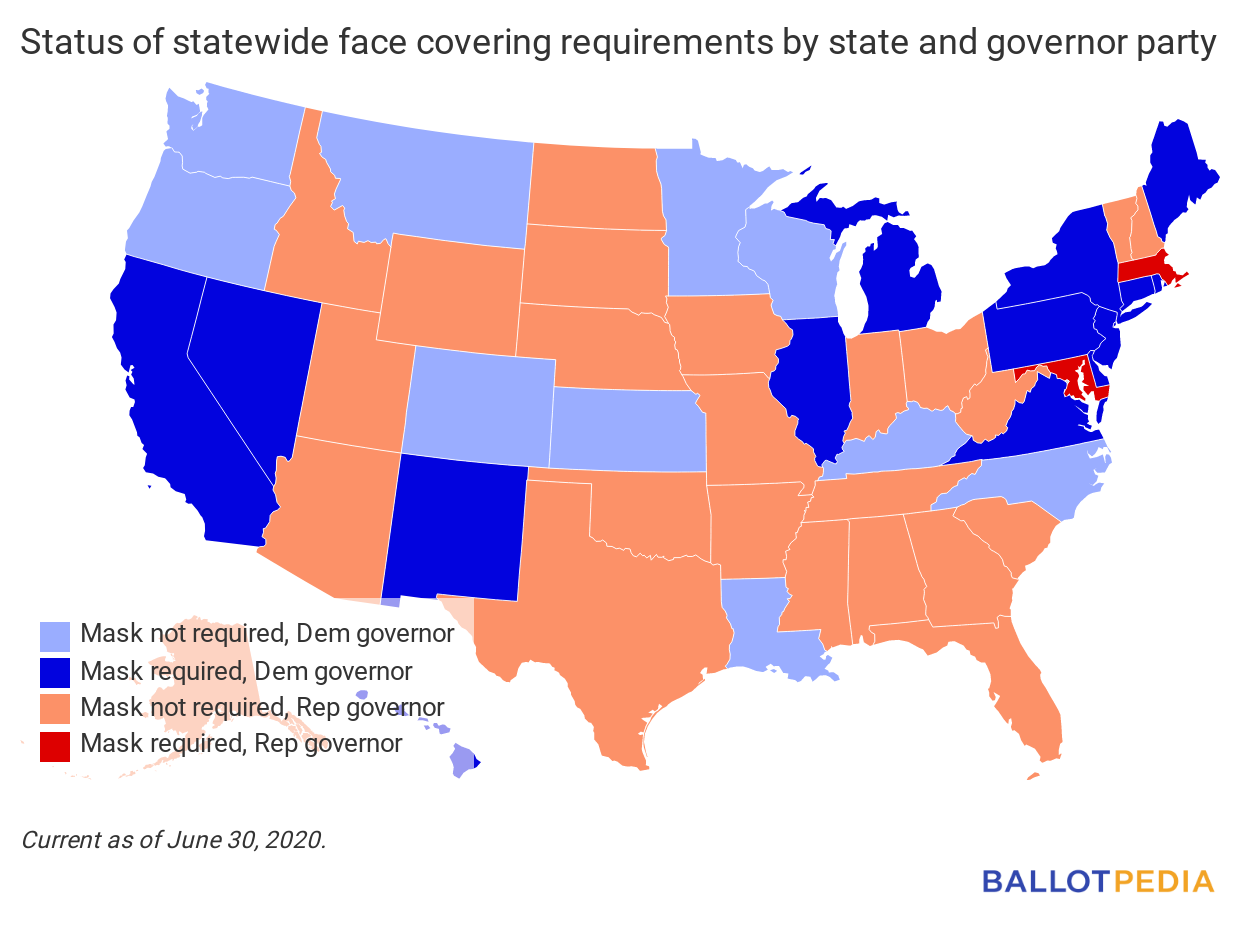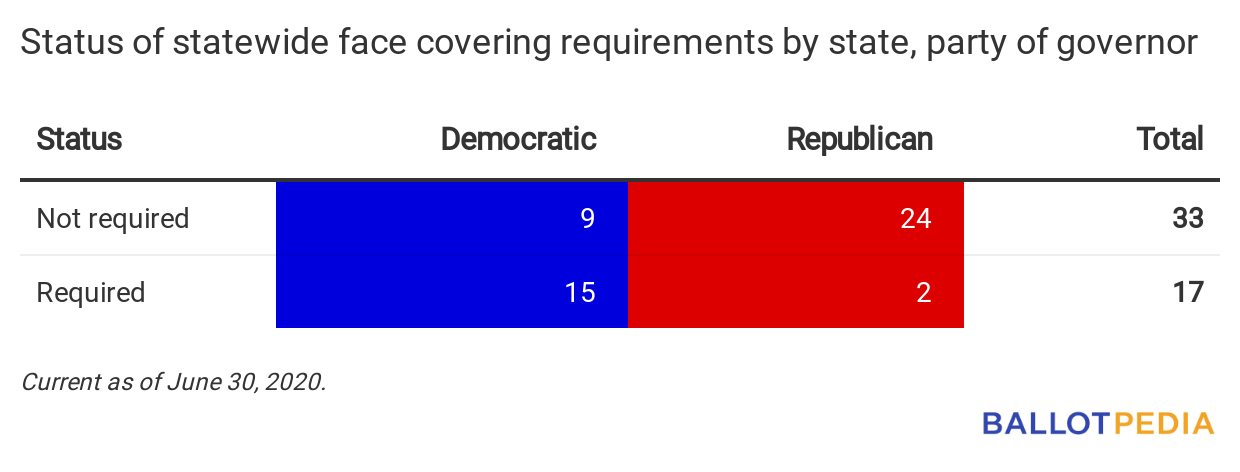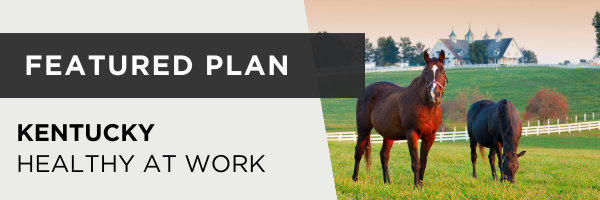Each day, we:
- Track the status of reopening in all 50 states.
- Compare the status of one industry or activity across the country.
- Provide in-depth summaries of the latest reopening plans.
- Give you the latest stories on other reopening plans and ideas.
Want to know what happened yesterday? Click here.
The next two days
What is reopening in the next two days?
July 1
- Maine (Democratic trifecta): Effective July 1, the following businesses will be permitted to reopen or expand operations: indoor amusement facilities (e.g., bowling alleys; 50 people maximum); movie theaters (50 people maximum); outdoor amusement facilities (25% capacity); performing arts venues (50 people maximum); casinos; overnight summer camps; and spas and close-contact personal services (e.g., nail services; 50 people maximum).
- Oregon (Democratic trifecta): Gov. Kate Brown (D) announced face coverings in indoor public spaces will be required statewide, effective July 1. Face coverings have been required in Multnomah, Clackamas, Washington, Marion, Polk, Hood River, and Lincoln counties since June 24.
- Virginia (Democratic trifecta): Virginia will enter Phase 3 of its reopening plan on July 1. Retailers, restaurants, and bars will no longer be subject to capacity restrictions, and entertainment venues and gyms will be permitted to operate at high capacities. The limit on gatherings will increase to 250 people.
Since our last edition
What is open in each state? For a continually updated article on reopening status in all 50 states, click here. For our last edition, click here.
- Arizona (Republican trifecta): Gov. Doug Ducey (R) ordered bars, movie theaters, and water parks to close for at least one month. He also ordered public schools to delay the start of the school year until at least August 17. According to KTAR, most of the state’s public school systems traditionally begin their school years in early August.
- Connecticut, New Jersey, New York (Democratic trifectas): Govs. Ned Lamont (D-Conn.), Phil Murphy (D-N.J.), and Andrew Cuomo (D-N.Y.) announced June 30 that visitors arriving in their states from eight additional states will be required to self-quarantine for 14 days. The three governors announced the joint travel advisory on June 24. The initial list included eight states. The new states include California, Georgia, Iowa, Idaho, Louisiana, Mississippi, Nevada, and Tennessee.
- Georgia (Republican trifecta): Gov. Brain Kemp (R) extended the state’s social distancing rules for businesses and vulnerable residents. Kemp also extended the state’s public health emergency until August 11. The emergency includes a ban on gatherings of up to 50 individuals.
- Kansas (divided government): On June 29, Gov. Laura Kelly (D) announced she would issue an executive order requiring most Kansans to wear face coverings in public spaces, effective 12:01 a.m. on July 3. Kelly said, “I know Kansans will have many questions about this order – and we will answer them when it is released later this week. But by announcing the requirement today, people in our state will have the appropriate time to acquire the masks.”
- Kentucky (divided government): On June 29, Kentucky entered into the final stage of its reopening plan. As a result, the state’s stay-at-home order, which did not have a fixed end date, effectively concluded.
- Michigan (divided government): At 3:00 p.m., June 30, Gov. Gretchen Whitmer (D) was expected to announce whether the state or portions thereof, are ready to advance to Phase 5 of Michigan’s reopening plan. She was also expected to discuss the state’s plan for reopening schools in the fall. We’ll have more information on these developments in tomorrow’s newsletter.
- Massachusetts (divided government): Gov. Charlie Baker (R) announced that out-of-state visitors from Rhode Island, Connecticut, Vermont, New Hampshire, Maine, New York, and New Jersey will no longer need to self-quarantine for 14 days.
- Nevada (Democratic trifecta): Gov. Steve Sisolak (D) announced that Nevada would remain in Phase 2 of its reopening plan through the end of July.
- New York (Democratic trifecta): The Western New York region is moving to Phase IV of the state’s reopening plan on June 30.
- Ohio (Republican trifecta): At a press conference on Monday, June 29, Gov. Mike DeWine (R) announced that he was extending several health orders that were set to expire July 1. The orders established reopening requirements for industries like restaurants, gyms, and campgrounds. DeWine said he was extending the orders while he works on developing plans for the next phase of reopening, which could be released as early as Thursday. DeWine also announced that nursing homes can offer outdoor visitations so long as certain requirements are met beginning July 20.
- Rhode Island (Democratic trifecta): Rhode Island is moving to the third phase of reopening on June 30. Phase 3 allows gatherings of up to 25 people indoors and 50 outdoors. It also permits entertainment businesses (like bowling alleys and movie theaters) and some larger events (like concerts and festivals) to reopen with restrictions. Gov. Gina Raimondo (D) said Rhode Island will require travelers from states with 5% or greater positivity rates to self-quarantine for 14 days or be able to present proof of a recent negative coronavirus test.
- Tennessee (Republican trifecta): On Monday, June 29, Gov. Bill Lee (R) extended the state of emergency declaration through August 29. The order continues the suspension and extension of some laws, regulations, and deadlines, including allowing restaurants to offer take-out and delivery of alcohol and pushing back the date at which drivers licenses need to be renewed. Lee also issued an executive order permitting local governments to continue to meet remotely.
- Texas (Republican trifecta): Gov. Greg Abbott (R) announced Tuesday, June 30, that he was pausing elective surgeries in four additional counties, bringing the total number of counties with bans on elective surgeries to eight. The eight counties have experienced an increase in COVID-19 cases and hospitalizations.
Update on stay-at-home orders
Forty-three states issued orders directing residents to stay home except for essential activities and the closure or curtailment of businesses each state deemed nonessential. Seven states did not.
As of June 30, stay-at-home orders have ended in 42 states. Nineteen of those states have Republican governors and 23 have Democratic governors (including Wisconsin, where the state supreme court invalidated the stay-at-home order).
California, which has a Democratic governor, is the only remaining state with an active stay-at-home order.
Here’s which stay-at-home orders have expired.

Tracking industries: Face coverings
All 50 states are reopening in some way. Here, we give the status of one industry or activity across the states. Today’s question: in which states must you wear a face covering in public?
We last looked at face coverings in the June 22nd edition of the newsletter. Since then, no requirements have changed. Two states will implement requirements this week, however.
- Kansas: Kansas’ face covering requirement will take effect on July 3.
- Oregon: Oregon’s face covering requirement will take effect on July 1.
No statewide face covering requirements have ended since June 22.
 
|

This is an in-depth summary of one of the latest reopening plans. Is there a plan you’d like us to feature? Reply to this email and let us know. Click a state below to read a previous Featured Plan.
Kentucky Gov. Andy Beshear (D) announced the Healthy At Work reopening plan on April 29. The plan initially took effect May 11, allowing non-essential construction and manufacturing, horse racing, pet grooming and boarding, and office-based businesses to resume operations.
In a press release announcing the plan, Beshear said, “We’ve got to do this right. I believe we can do this right. When we phase back in to work, remember, you don’t need an in-person meeting. Use the telephone. And now that we are starting to open up health care, see your doctor if you need to.”
The state completed the formal plan on June 29 with the reopening of bars and restaurants, public pools, and larger event spaces. The final batch of reopenings also permitted gatherings of up to 50 people.
According to the reopening plan, the following benchmarks were considered in deciding to reopen:
| “ |
- 14 days of decreasing cases
- Increased testing capacity on contact tracing
- Personal protective equipment (PPE) availability
- Ability to protect at-risk populations
- Ability to social distance and follow the CDC’s guidelines on large gatherings
- Preparedness for possible future spike
- Status of vaccine and treatment
|
” |
Context
- Kentucky’s statewide stay-at-home order took effect on March 26. The order did not have a fixed end date. Its provisions began to lapse when the state began its reopening process on May 11. On June 29, Kentucky reached the end of its formal reopening plan, marking the effective end of the stay-at-home order.
- As of June 29, there had been 14,835 confirmed positive cases of COVID-19 in Kentucky and 557 confirmed deaths. A total of 394,773 residents had been tested, amounting to a positive test rate of 3.8%. As of July 2019, Kentucky’s estimated population was 4.5 million. Per 100,000 residents, there have been 329.7 confirmed positives, 12.4 confirmed deaths, and 8772.7 total tests.
- Kentucky has a divided government, with a Democratic governor and Republican majorities in both chambers of the state legislature.
Plan details
General guidance
Individuals
Kentuckians were encouraged to:
- Stay home as much as possible
- Observe 6-feet social distancing
- Wear masks per CDC guidance
Businesses
All open businesses are required to comply with the following minimum requirements:
| “ |
- Enforce Social Distancing (six (6) feet or more)
- Universal masking
- Provide Adequate Hand Sanitizer and Encourage Hand Washing
- Ensure Proper Sanitation
- Conduct Daily Temperature/Health checks
|
” |
Reopening timeline
The below timeline details Kentucky’s reopening process. Click on each date to view the relevant reopening order.
May 9, 2020
- The following businesses and services were allowed to open:
May 11, 2020
- The following businesses and services were allowed to open:
- Non-essential construction
- Horse racing venues (no fans permitted)
- Non-essential manufacturing and distribution
- Office-based businesses
- Pet grooming and boarding
- Photography
- Vehicle dealerships
May 18, 2020
- The following businesses and services were allowed to open:
- Government offices and agencies
May 20, 2020
- The following businesses and services were allowed to open:
- Funeral and memorial services
- Non-essential retail
May 22, 2020
- The following changes to individual restrictions took effect:
- Gatherings of up to 10 people permitted
- Travel restrictions ended
- The following businesses and services were allowed to open:
- Dine-in restaurant services (33% capacity)
May 25, 2020
- The following businesses and services were allowed to open at 33% capacity:
- Barbershops and hair salons
- Beauty parlors
- Massage parlors
- Tanning salons
- Tattoo parlors
June 1, 2020
- The following businesses and services were allowed to open:
- Auctions
- Auto and dirt tracks
- Aquatic centers
- Bowling alleys
- Fishing tournaments
- Gyms and fitness centers
- Kentucky State Park lodges
- Movie theaters
- Salato Wildlife Education Center
June 8, 2020
- The following businesses and services were allowed to open:
- Aquariums
- Distilleries
- Indoor entertainment (like arcades, laser tag venues, roller skating rinks)
- Libraries
- Outdoor attractions
- Museums
- Horse shows
- In-home childcare programs
June 10, 2020
- The following businesses and services were allowed to open:
- Places of worship (capacity increased to 50%)
June 11, 2020
- The following businesses and services were allowed to open:
- Kentucky Horse Park
- Kentucky State Park campgrounds
- Vehicle dealerships (capacity increased to 50%)
June 15, 2020
- The following businesses and services were allowed to open:
- Center-based childcare programs and day camps
- Low-touch youth sports
June 18, 2020
- The following businesses and services were allowed to open:
- Government offices and agencies (capacity increased to 50%)
June 20, 2020
- The following businesses and services were allowed to open at increased, 50% capacity:
- Funeral and memorial services
- Non-essential retail
June 22, 2020
- The following businesses and services were allowed to open:
- Dine-in restaurant services (capacity increased to 50%)
June 25, 2020
- The following businesses and services were allowed to open at increased, 50% capacity:
- Barbershops and hair salons
- Beauty parlors
- Massage parlors
- Tanning salons
- Tattoo parlors
June 29, 2020
- The following changes to individual restrictions took effect:
- Gatherings of up to 50 people permitted
- The following businesses and services were allowed to open:
- Bars
- Public swimming and bathing facilities
- Event venues
- Youth sports (high-touch sports like football, soccer, and lacrosse can resume practices)
Reactions
- On April 15, Scott Hofstra, spokesman for the United Kentucky Tea Party, said Kentucky was not reopening quickly enough. He said, “People are frustrated, and they’re not having input on this at all because the governor is dictating. … The governor is putting a higher priority on locking the entire state down for a virus that, as of a day or so ago, had a death rate that is 1/6th of the traffic accidents in Kentucky.”
- On May 4, La Tasha Buckner, Beshear’s chief of staff, said waiting to reopen based on the Healthy At Work criteria was necessary to public health and would allow the state to make steadier reopening progress. She said, “It’s important that you meet these guidelines, these requirements, because it allows us to be healthy at work. That allows us the successful reopening and to make sure we’re making advancements and staying at the plateau level and hopefully declining.”
Additional activity
In this section, we feature examples of activities by other federal, state, and local governments and influencers relevant to recovering from the pandemic.
- Effective June 29, residents of Anchorage, Alaska, were required to wear masks inside all buildings aside from their homes within the municipality.
- On June 11, the U.S. Court of Appeals for the District of Columbia Circuit denied an emergency petition filed by the AFL-CIO. The labor union had sought a court order (a writ of mandamus) to compel the Occupational Safety and Health Administration (OSHA) to issue an Emergency Temporary Standard for Infectious Diseases (ETS) to protect working people from occupational exposure to COVID-19. The AFL-CIO had first petitioned Secretary of Labor Eugene Scalia on March 6 to issue the ETS, but Scalia did not act on the petition, prompting the AFL-CIO to take the matter before the D.C. Circuit. The labor union cited a federal law requiring the issuance of an ETS when “employees are exposed to grave danger from exposure to substances or agents determined to be toxic or physically harmful or from new hazards.” The D.C. Circuit refused to compel action, saying that OSHA is “entitled to considerable deference” and the agency had “reasonably determined that an ETS is not necessary at this time.” The per curiam decision was made by Judges Karen Henderson, an appointee of George H.W. Bush (R), Robert Wilkins, an appointee of Barack Obama (D), and Neomi Rao, an appointee of Donald J. Trump (R). AFL-CIO President Richard Trumka issued a statement the day of the decision, saying, “the court’s action today fell woefully short of fulfilling its duty to ensure that the Occupational Safety and Health Act is enforced.”
- In California, Alameda and Contra Costa counties announced that they were pausing their reopening plans, which both counties were scheduled to proceed to the next phase this week. Two other Bay Area counties, San Francisco and Marin, announced delays to their reopening plans last week.
- The Cherokee Nation announced June 29 that it would stay in the second phase of its reopening plan through August 3. The third phase was originally planned to begin on July 6. The third phase would allow Cherokee offices to return to full staff, except for those over 65, who would be allowed to continue working from home or taking administrative leave.
|





